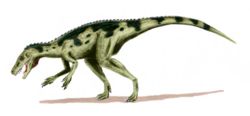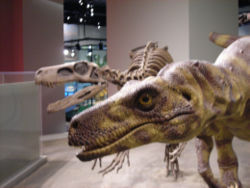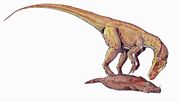黑瑞龍
艾雷拉龙
维基百科,自由的百科全书
|
化石時期: 晚三疊紀 |
||||||||||||||||||||
|---|---|---|---|---|---|---|---|---|---|---|---|---|---|---|---|---|---|---|---|---|
 |
||||||||||||||||||||
| 科學分類 | ||||||||||||||||||||
|
||||||||||||||||||||
| 二名法 | ||||||||||||||||||||
| 伊斯基瓜拉斯托艾雷拉龍 Herrerasaurus ischigualastensis Reig, 1963 |
||||||||||||||||||||
| 異名 | ||||||||||||||||||||
艾雷拉龍(學名Herrerasaurus),又稱黑瑞龍、黑瑞拉龍或赫勒拉龍,是最早的肉食性恐龍之一。所有已知的標本都是在阿根廷巴塔哥尼亞西北部的三疊紀晚期地層發現。模式種伊斯基瓜拉斯托艾雷拉龍(H. ischigualastensis)是由Osvaldo Reig於1963年描述[1],且是此屬的唯一物種。
多年來艾雷拉龍的分類都不清楚,原因是牠最初只有一些碎片化石。牠曾被認為是基礎獸腳亞目恐龍、基礎蜥腳形亞目恐龍、基礎蜥臀目恐龍、或者不是恐龍。但是,隨著1988年發現了大部份完整的骨骼及頭顱骨後,艾雷拉龍被分類為早期的獸腳亞目或蜥臀目。[2][3]艾雷拉龍是中型的雙足恐龍,屬於艾雷拉龍科,這是一類最早期恐龍演化擴散的動物。
目录 |
描述
艾雷拉龍是輕巧的肉食性恐龍,有長尾及相對細小的頭。牠的長度估計有3-6米[3],臀部高度超過1.1米,體重約為210-350公斤。[4]在最初被認為是富倫格里龍的標本中,估計頭部最小長56厘米。[4]
頭顱骨
艾雷拉龍的頭顱骨長而且窄,且幾乎沒有所有後期恐龍的特徵[5],卻與較原始的初龍類(如派克鱷)沒有多大分別。牠的頭顱骨上有5對窗孔,其中兩對是眼窩及鼻孔。在眼睛與鼻孔之間是兩個眶前孔及一對長1厘米像裂縫的窗孔。[6]在眼睛後是大的顳下孔。這些窗孔有助於減低頭顱骨重量。
艾雷拉龍的下顎骨是一個柔軟的關節,這可以容許牠的下顎骨前後移動,抓住獵物。[5]這種特徵在其他恐龍並不常見,但一些蜥蜴仍保有這種特徵。[7]下顎的後部亦有窗孔。顎骨上有鋸齒狀牙齒,牙齒往後彎曲,頸部幼長及靈活。[5][8]
四肢
艾雷拉龍的前肢相對較短,是後肢長度的一半。肱骨及脛骨較短,而手部拉長。頭二指及拇指都有鋒利及彎曲的爪,可以抓住獵物。第四及第五指很短小及沒有爪。[3][9]艾雷拉龍可能是最早的恐龍之一,或是最早有雙足獸腳亞目形態的動物。牠的後肢強壯,位於身體正下方,大腿骨較短,而腳掌較長,可見牠善於奔跑。用作平衡的尾巴,會以重疊的尾椎來使部份硬化,這亦是適合高速的構造。[10]
衍生及基底特徵
艾雷拉龍是謎一樣的生物,有很多不同恐龍的特徵。雖然牠有大部份恐龍的特徵,但都存在著差異之處,尤其是在臀部及肢骨的形狀上。牠的盆骨與蜥臀目相似,但髖臼只是部份中空。腸骨只以兩根薦骨支撐,是一種基礎特徵[10];恥骨向後,則是馳龍科及鳥類的衍生特徵。再者,恥骨的末端是呈靴形,與鳥獸腳類的很相似;脊骨的形狀亦有像異特龍的沙漏形狀。[4]
分類
艾雷拉龍屬於三疊紀中期至晚期同名的艾雷拉龍科,但是這科在演化樹上的位置卻不清楚。牠們可能是基礎獸腳亞目恐龍,或是基礎蜥臀目恐龍,或者其實是早於蜥臀目與鳥臀目分裂演化前的恐龍。分支內其他的成員包括同樣來自阿根廷伊斯基瓜拉斯托層的始盜龍、巴西南部發現的南十字龍[11]、美國阿利桑那州石化林國家公園(秦里層)的欽迪龍[12]及德克薩斯州的盒龍[13],但這些動物之間的關係卻不清楚,且亦非所有古生物學家也認同。其他可能的基礎獸腳亞目恐龍,如印度的艾沃克龍[14]及巴西三疊紀晚期的Teyuwasu都可能與艾雷拉龍有親屬關係。[15]奧尼拉斯·諾瓦斯(Fernando Novas)將艾雷拉龍科定義為包括艾雷拉龍、南十字龍及牠們的共同祖先。[16]保羅·塞里諾(Paul Sereno)將艾雷拉龍科意義為:包含伊斯基瓜拉斯托艾雷拉龍,而不包含家麻雀的最大演化支。[17]Max Langer則創立了一個較高層次的分類:艾雷拉龍下目。[10]
歷史
艾雷拉龍是由古生物學家Osvaldo Reig為紀念於1959年發現其化石的Victorino Herrera而命名的。[1]發現的岩層(後來亦發掘出始盜龍[18]),是屬於伊斯基瓜拉斯托層,估計可追溯至三疊紀晚期拉丁尼階至卡尼階。[19]Reig在發表艾雷拉龍的文章上同時命名了伊斯龍[1],但現時伊斯龍已被認為是艾雷拉龍的幼體及異名。[8] 另外兩個連同頭顱骨的部份骨骼,於1986年由奧尼拉斯·諾瓦斯命名為富倫格里龍[20],但這個物種亦被認為是異名。[8]
Reig相信艾雷拉龍是早期肉食龍下目的例子[1],但在期後的30年這個假設被受爭論,而艾雷拉龍亦多次被分類在不同的位置。於1970年,艾雷拉龍被認為是原蜥腳下目。[21]於1972年,彼得·加爾東(Peter M. Galton)認為牠是蜥臀目。[22]後來一些學者利用親緣分支分類法將艾雷拉龍及南十字龍分類為,鳥臀目及蜥臀目分裂演化之前的恐龍演化樹底部。[23][24][16][25]幾個學者更認為牠並非恐龍。
艾雷拉龍的完整頭顱骨要到1988年才由保羅·塞里諾的古生物學家隊伍發現。[3][26]基於新的化石資料,湯瑪斯·荷茲(Thomas Holtz)[27]及約瑟·波拿巴(José F. Bonaparte)[28]等學者將艾雷拉龍分類在蜥臀目演化樹的底部,在原蜥腳下目及獸腳亞目分化之前。但是,塞里諾則偏向認為艾雷拉龍是原始獸腳亞目。這兩個分類都有其支持者。Oliver Rauhut[29]及Bittencourt與Kellner[30]支持早期獸腳亞目的假說,Max Langer[10]、Langer與麥可·班頓(Michael J. Benton)[31]及Randall Irmis等人[32]支持基礎蜥臀目恐龍的假說。若艾雷拉龍真的是獸腳亞目,這顯示了獸腳亞目、蜥腳形亞目及鳥臀目的分化比艾雷拉龍科更早出現,而三個分支獨立地演化出幾種恐龍特徵,如進化的腳跟關節或中空的髖臼。[33]這個意見更得到了足跡化石學紀錄的支持,足跡化石學發現屬於獸腳亞目的大型三趾腳印,從阿根廷Los Rastros地層屬於拉丁尼階來推斷,估計艾雷拉龍的年代可推前3-5百萬年。[34][35]
艾雷拉龍及始盜龍的遺骸可以幫助直接測示恐龍從單一源頭演化的理論。恐龍為單系群是於1970年代提出的[36][37],有9個頭蓋及50個顱後的共有衍徵被列出。但是,在研究艾雷拉龍後,只有1個頭蓋及7個顱後的共有衍徵被認同,更有另一個新的發現。[3]
古生態學
雖然艾雷拉龍與大型的肉食性恐龍有同樣的體型,但是牠是卻是生活在2千3百萬年前,恐龍還是很細小的時代。那時是非恐龍蜥蜴的時代及地球生態轉變的時代。伊斯基瓜拉斯托層的脊椎動物群及後期的洛斯科洛拉多斯組都包含了不同的鑲嵌踝類初龍及單孔亞綱。[38][39]例如在伊斯基瓜拉斯托層,只有6%的化石是恐龍。於三疊紀末,恐龍才支配陸地,而其他鑲嵌踝類初龍及單孔亞綱則失去了多樣性。
有研究指伊斯基瓜拉斯托層的古生態環境是火山活躍及充滿森林的氾濫平原,而季節性降雨量亦很多。生長的植物包括有枝脈蕨屬、木賊屬及巨大的松科。[39]這些植物形成了高地河岸森林。[3]艾雷拉龍是在伊斯基瓜拉斯托層最普遍的肉食性恐龍。[19]牠們與其他早期恐龍一同在三疊紀的南美洲森林生活,如始盜龍、蜥鱷[40]、巨大的陸地肉食性勞氏鱷目、脈鱷及犬齒獸亞目。[19]草食性的動物較肉食性的為多,當中有喙頭龍科(如異平齒龍)、堅蜥目、二齒獸下目及Traversodontidae科。牠們的數目都是較像皮萨诺龙的鳥臀目恐龍更多。[41]
古生物學
艾雷拉龍的牙齒顯示牠是肉食性的。牠的體型顯示牠獵食小型及中型的動物。牠有可能吃其他恐龍,如草食性的皮萨诺龙。但是由於艾雷拉龍生活的時代恐龍並未普及,主要的獵物會包括喙頭龍科及堅蜥目。從一個艾雷拉龍頭顱骨的咬痕估計,牠本身可能是巨大的勞氏鱷目(如蜥鱷)的獵物。[5]
從伊斯基瓜拉斯托層發現的糞化石,因艾雷拉龍化石的豐富,被編入了艾雷拉龍屬中。這些糞化石包含了細小的骨頭,但卻沒有植物碎片。從糞化石的礦物質及化學分析中發現,艾雷拉龍有消化骨頭的能力。[42]
參考
- ^ 1.0 1.1 1.2 1.3 Reig, O.A.(1970年). “La presencia de dinosaurios saurisquios en los "Estratos de Ischigualasto" (Mesotriásico Superior) de las provincias de San Juan y La Rioja (República Argentina)”.Ameghiniana.3(1):3-20.
- ^ Sereno, P.C.,Novas, F.E.; Arcucci, A.B.; and C. Yu(1988年). “New evidence on dinosaur and mammal origins from the Ischigualasto Formation (Upper Triassic, Argentina)”.Journal of Vertebrate Paleontology.8(3, supplement):26A.
- ^ 3.0 3.1 3.2 3.3 3.4 3.5 Sereno, P.C.,and Novas, F.E.(1992年). “The complete skull and skeleton of an early dinosaur”.Science.258:1137-1140.
- ^ 4.0 4.1 4.2 Paul, G.S.(1988).Predatory Dinosaurs of the World.New York:Simon and Schuster,248-250.
- ^ 5.0 5.1 5.2 5.3 Sereno, P.C.,and Novas, F.E.(1993年). “The skull and neck of the basal theropod Herrerasaurus ischigualastensis”.Journal of Vertebrate Paleontology.13:451-476.
- ^ Sereno, P.C.(2008年3月5日).“The phylogenetic relationships of early dinosaurs: a comparative report”.Historical Biology.19(1):145-155.DOI:10.1080/08912960601167435.ISSN 0891-2963.
- ^ McDowell, S.B., Jr.,and C.M. Bogert(1970年). “The systematic position of Lanthanotus and the affinities of the anguinomorphan lizards”.Bulletin of the American Museum of Natural History.105:1-142.
- ^ 8.0 8.1 8.2 Novas, F. E.(1994年). “New information on the systematics and postcranial skeleton of Herrerasaurus ischigualastensis (Theropoda: Herrerasauridae) from the Ischigualasto Formation (Upper Triassic) of Argentina”.Journal of Vertebrate Paleontology.13(4):400-423.
- ^ Sereno, P.C.(1993年). “The pectoral girdle and forelimb of the basal theropod Herrerasaurus ischigualastensis”.Journal of Vertebrate Paleontology.13:425-450.
- ^ 10.0 10.1 10.2 10.3 Langer, Max C.(2004).“Basal Saurischia”,Weishampel, David B.; Dodson, Peter; and Osmólska, Halszka (eds.) 编:The Dinosauria,2nd,Berkeley:University of California Press,25-46.ISBN 0-520-24209-2.
- ^ Colbert, E.H.(1970). “A saurischian dinosaur from the Triassic of Brazil”.American Museum Novitates.2405:1-39.
- ^ Long, R.A.,and Murry, P.A.(1995年). “Late Triassic (Carnian and Norian) Tetrapods from the Southwestern United States”.New Mexico Museum of Natural History and Science, Bulletin 4:1-254.
- ^ Hunt, A.P.,Lucas, S.G.; Heckert, A.B.; Sullivan, R.M.; and Lockley, M.G.(1998年). “Late Triassic Dinosaurs from the Western United States”.Geobios.31(4):511-531.
- ^ Chatterjee, S.,and Creisler, B.S.(1994年). “Alwalkeria (Theropoda) and Morturneria (Plesiosauria), new names for preoccupied Walkeria Chatterjee, 1987 and Turneria Chatterjee and Small, 1989”.Journal of Vertebrate Paleontology(1):142.
- ^ Kischlat, E.-E.(1999年). “A new dinosaurian “rescued” from the Brazilian Triassic: Teyuwasu barberenai, new taxon”.1st Simp. Brasil. Pal. Vert, Paleontologia em Destaque.14(26):58.
- ^ 16.0 16.1 Novas, F. E.(1992年). “Phylogenetic relationships of the basal dinosaurs, the Herrerasauridae”.Palaeontology.35:51-62.
- ^ Sereno, P.C.(1998年). “A rationale for phylogenetic definitions, with application to the higher-level taxonomy of Dinosauria”.Neues Jahrbuch für Geologie und Paläontologie, Abhandlungen.210(1):41-83.
- ^ Sereno, P.C.,Forster, C.A.; Rogers, R.R.; and Monetta, A.M.(1993年). “Primitive dinosaur skeleton from Argentina and the early evolution of Dinosaurs”.Nature.361(6407):64-66.
- ^ 19.0 19.1 19.2 Rogers, R. R.,Swisher III, C.C.; Sereno, P.C.; Monetta, A.M.; Forster, C.A.; and Martinez, R.N.(1993年). “The Ischigualasto tetrapod assemblage (Late Triassic, Argentina) and 40Ar/39Ar dating of dinosaur origins”.Science.260:794–797.
- ^ Novas, F. E.(1986年). “Un probable terópodo (Saurischia) de la Formación Ischigualasto (Triásico superior), San Juan, Argentina”.IV Congreso Argentino de Paleontología y Bioestratigrafía, Mendoza, november 23-27.2:1-6.
- ^ Steel, R.(1970). “Part 14. Saurischia. Handbuch der Paläoherpetologie/Encyclopedia of Paleoherpetology”.Gustav Fischer Verlag, Stuttgart:1-87.
- ^ Galton, P.M.(1973年). “On the anatomy and relationships of Efraasia diagnostica (Huene) n.gen., a prosauropod dinosaur (Reptilia: Saurischia) from the Upper Triassic of Germany.”.Paläontologische Zeitschrift.47(3/4):229-255.
- ^ Paul, G.S.(1984年). “The segnosaurian dinosaurs: relics of the prosauropod-ornithischian transition?”.Journal of Vertebrate Paleontology.4:507-515.
- ^ Novas, F. E.(1989年). “The tibia and tarsus in Herrerasauridae (Dinosauria, incertae sedis) and the evolution and origin of the dinosaurian tarsus”.Journal of Paleontology.63:677–690.
- ^ Brinkman, D.B.,and Sues, H.-D.(1987年). “A staurikosaurid dinosaur from the Upper Triassic Ischigualasto Formation of Argentina and the relationships of the Staurikosauridae”.Palaeontology.30:493-503.
- ^ “The Nature of the Beast” The Dinosaurs!. 1990年.
- ^ Holtz, T.R., Jr.,and Padian, K.(1995年). “Definition and diagnosis of Theropoda and related taxa”.Journal of Vertebrate Paleontolology.15(3, supplement):35A.
- ^ Bonaparte, J.F.,and Pumares, J.A.(1995年). “Notas sobre el primer cráneo de Riojasaurus incertus (Dinosauria, Prosauropoda, Melanorosauridae) del Triásico superior de La Rioja, Argentina”.Ameghiniana.32:341-349.
- ^ Rauhut, O.W.M.(2008年3月5日). “The interrelationships and evolution of basal theropod dinosaurs”.Special Papers in Palaeontology.69:1-213.
- ^ Bittencourt, J.,and Kellner, W.A.(2008年3月5日). “The phylogenetic position of Staurikosaurus pricei from the Triassic of Brazil”.Journal of Vertebrate Paleontology.24(3, supplement):39A.
- ^ Langer, M.C,and Benton, M.J.(2008年3月5日). “Early dinosaurs: a phylogenetic study”.Journal of Systematic Palaeontology.4(4):309-358.
- ^ Irmis, Randall B.,Nesbitt, Sterling J.; Padian, Kevin; Smith, Nathan D.; Turner, Alan H.; Woody, Daniel; and Downs, Alex(2007年). “A Late Triassic dinosauromorph assemblage from New Mexico and the rise of dinosaurs”.Science.317:358-361.DOI:10.1126/science.1143325.
- ^ White, A.T.,and Kazlev, M.A.(2008年3月5日).Theropoda: Basal Theropods.Palaeos.com.於2007年7月20日查閱.
- ^ Forster, C.A.,Arcucci, A.B.; Marsicano, C.A.; Abdala, F.; and May, C.L.(1995年). “New vertebrate material from the Los Rastros Formation (Middle Triassic), La Rioja province, northwestern Argentina”.Journal of Vertebrate Paleontology.15(3, supplement):29A.
- ^ Arcucci, A. C.,Forster, C.; May, Abdala, F.; and Marsicano, C.(1998年). “Una nueva icnofauna de la Formación Los Rastros, Triásico Medio, en la Quebrada de Ischichuca Chica (Provincia de La Rioja, Argentina)”.Acta Geológica Lilloana.18:152.
- ^ Bakker, R.T.,and Galton, P.M.. “Dinosaur monophyly and a new class of vertebrates”.Nature.248:168-172.DOI:10.1038/248168a0.
- ^ Bonaparte, J. F.(1976年). “Pisanosaurus mertii Casimiquela and the origin of the Ornithischia”.Journal of Paleontology.50:808–820..
- ^ Bonaparte, J. F.(1982年). “Faunal replacement in the Triassic of South America”.Journal of Vertebrate Paleontology.2:362–371.
- ^ 39.0 39.1 (Spanish)Bonaparte, J.F.(1979年). “Faunas y paleobiogeografía de los tetrápodos mesozoicos de América del Sur”.Ameghiniana, Revista de la Asociación Paleontológica Argentina.16(3-4):217-238.
- ^ Sill, W.D.(1974年). “The anatomy of Saurosuchus galilei and the relationships of the rauisuchid thecodonts”.Bulletin of the Museum of Comparative Zoology.146:317–362.
- ^ Bonaparte, J.F.(1970). “Annotated list of the South American Triassic tetrapods”.Gondwana Symposium Proceedings and Papers.2:665-682.
- ^ Hollocher, K.T.,Alcober, O.A.; Colombi, C.E.; and Hollocher, T.C.(2005年). “Carnivore coprolites from the Upper Triassic Ischigualasto Formation, Argentina: chemistry, mineralogy, and evidence for rapid initial mineralization”.PALAIOS.20:51–63.
外部連結
This article is licensed under the GNU Free Documentation License. 所用資料來源於文章"黑瑞龍".

